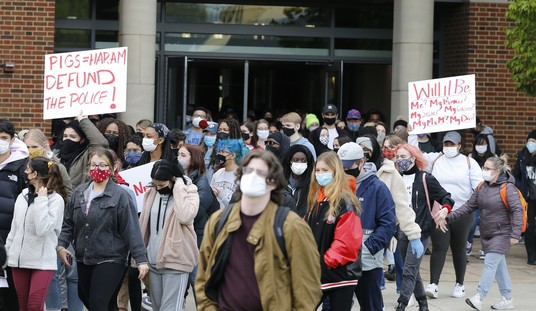
A faithful waves a Chinese flag as Pope Francis arrives for his weekly general audience in St. Peter’s Square at the Vatican, Wednesday, June 6, 2018. (AP Photo/Gregorio Borgia)
China represents an existential threat to the national security of the US in terms of growth of military capabilities but more importantly in the economic realm as they pursue their “Made in China 2025” and Belt-Road initiatives. Fortunately, more and more people are recognizing the threat, thanks to the laser-like focus of the Trump Administration on resetting the trade balance with China. And the ongoing ChiCom threats against the Hong Kong protectorate showcase Beijing’s threat to the entire region.
There are a number of voluminous and detailed reports produced by US government entities over the past few years that are intended to educate Americans. These reports contain a LOT of quite shocking information that we have ignored for a generation or more. However, in the fast-paced and social media-driven American culture, few people other than academics and national security professionals seem to take the time to truly read and understand the Chinese threat, especially in the economic realm. The purpose of this series is to elucidate the contents of one of those reports in “bite-sized chunks” that are more easily digestible in order to convey a better understanding of the Chinese economy and its long-term challenges to the US and the world.
The Congressional Research Service (CRS) works exclusively for the United States Congress, providing policy and legal analysis to committees and Members of both the House and Senate, regardless of party affiliation. As a legislative branch agency within the Library of Congress, CRS has been a valued and respected resource on Capitol Hill for more than a century. CRS is well-known for analysis that is authoritative, confidential, objective and nonpartisan. Its highest priority is to ensure that Congress has 24/7 access to the nation’s best thinking. CRS recently produced a report entitled, “China’s Economic Rise: History, Trends, Challenges, and Implications for the United States.” This report is the basis for this series.
Let’s get started with the first bite-sized chunk; here is the report’s summary:
Prior to the initiation of economic reforms and trade liberalization nearly 40 years ago, China maintained policies that kept the economy very poor, stagnant, centrally controlled, vastly inefficient, and relatively isolated from the global economy. Since opening up to foreign trade and investment and implementing free-market reforms in 1979, China has been among the world’s fastest-growing economies, with real annual gross domestic product (GDP) growth averaging 9.5% through 2018, a pace described by the World Bank as “the fastest sustained expansion by a major economy in history.” Such growth has enabled China, on average, to double its GDP every eight years and helped raise an estimated 800 million people out of poverty.
China has become the world’s largest economy (on a purchasing power parity basis), manufacturer, merchandise trader, and holder of foreign exchange reserves. This in turn has made China a major commercial partner of the United States.
China is the largest U.S. merchandise trading partner, biggest source of imports, and third-largest U.S. export market. China is also the largest foreign holder of U.S. Treasury securities, which help fund the federal debt and keep U.S. interest rates low.
As China’s economy has matured, its real GDP growth has slowed significantly, from 14.2% in 2007 to 6.6% in 2018, and that growth is projected by the International Monetary Fund (IMF) to fall to 5.5% by 2024.
The Chinese government has embraced slower economic growth, referring to it as the “new normal” and acknowledging the need for China to embrace a new growth model that relies less on fixed investment and exporting, and more on private consumption, services, and innovation to drive economic growth. Such reforms are needed in order for China to avoid hitting the “middle-income trap,” when countries achieve a certain economic level but begin to experience sharply diminishing economic growth rates because they are unable to adopt new sources of economic growth, such as innovation.
The Chinese government has made innovation a top priority in its economic planning through a number of high-profile initiatives, such as “Made in China 2025,” a plan announced in 2015 to upgrade and modernize China’s manufacturing in 10 key sectors through extensive government assistance in order to make China a major global player in these sectors. However, such measures have increasingly raised concerns that China intends to use industrial policies to decrease the country’s reliance on foreign technology (including by locking out foreign firms in China) and eventually dominate global markets.
In 2017, the Trump Administration launched a Section 301 investigation of China’s innovation and intellectual property policies deemed harmful to U.S. economic interests. It subsequently raised tariffs by 25% on $250 billion worth of imports from China, while China increased tariffs (ranging from 5% to 25%) on $110 billion worth of imports from the United States. Such measures have sharply decreased bilateral trade in 2019. On May 10, 2019, President Trump announced he was considering raising tariffs on nearly all remaining products from China. A protracted and escalating trade conflict between the United States and China could have negative consequences for the Chinese economy.
China’s growing global economic influence and the economic and trade policies it maintains have significant implications for the United States and hence are of major interest to Congress. While China is a large and growing market for U.S. firms, its incomplete transition to a free-market economy has resulted in economic policies deemed harmful to U.S. economic interests, such as industrial policies and theft of U.S. intellectual property.
This series will provide background on and the history of China’s economic rise; describe its current economic structure; provide a measure of the size of the Chinese economy; examine the impact of foreign direct investment and outflows in China; summarize Chinese merchandise trading patterns; identify the challenges China faces to maintain economic growth; and discuss the challenges, opportunities, and implications of China’s economic rise for the US and the rest of the world.
The dilemma with evaluating the Chinese economy is that the ChiComs obfuscate their economic date despite having joined the World Trade Organization in 2001. This step was to have “opened China’s financial books,” but the renminbi/yuan remains a closed currency and highly subject to manipulations – which is exactly what the Chinese do to further their goals of economic expansion and domination, consistent with their “Made in China 2025” and “Belt-Road” initiatives. More on them later in the series.
The end.














Join the conversation as a VIP Member